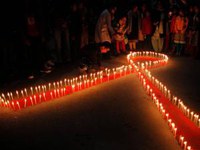
HIV is still an emergency

This was the stark reminder to South Africans by the Treatment Action Campaign (TAC) as the organisation painted a picture of a government becoming increasingly complacent in its strategies to fight the pandemic.
“Yet, international funding and the political will to deal with the epidemic is waning. There is a real risk that the Aids response will unravel,” TAC head of policy and communication Marcus Low said.
This comes as South Africa marks the commemoration of World Aids Day, when countries take stock of how far they have come in fighting the scourge. In South Africa, 6.4 million people - 10 percent of the population - have HIV. Only half are on treatment.
Each year, 350 000 are newly infected - about 1 000 people daily. And the new “face” of the disease is mainly young women of 15-24 increasingly bearing its brunt.
Last year, the Human Sciences Research Council released findings from its fourth national population-based survey, showing that females in the 15- to 19-year-old age group had a prevalence eight times more than males (5.6 percent vs 0.7 percent). Of concern was that the incidence rate among females aged 15-24 was four times higher than for males at 2.54 percent and 0.55 percent respectively.
Black African women’s incidence rate also ranked highest among population groups, at 4.5 percent in women between 20-34.
Buti Manamela, Deputy Minister in the Presidency for Planning, Monitoring and Evaluation, said: “There is a gender lens through which we must look at the data. Girls are vastly more affected, accounting for seven in 10 new infections among 15- to 19-year-olds in sub-Saharan Africa. Therefore our responses cannot be gender neutral.
“A troublesome statistic is that among 15- to 19-year-olds in sub-Saharan Africa, just over one in 10 are tested for HIV. Is this a case of stigma or discrimination? Not wanting to be tested because there is a label attached to being tested?”
On Sunday, Deputy President Cyril Ramaphosa raised concern over the number of young women affected by the disease, while emphasising the need to spread the word about prevention and encouraging condom use.
But Low countered this, saying: “Many young people still do not have access to comprehensive sex education and condoms. While the government is finally moving towards making condoms available at schools, this is happening too slowly. We know that young people are having sex but we are failing to give them the tools with which to protect themselves.”
Health Department spokesman Popo Maja defended the government, saying they had increased the number of male and female condoms distributed free of charge. He said the dynamics of HIV transmission in girls and young women was complex and needed a comprehensive combination prevention approach.
He admitted infection was still high and urged society to work harder to curb the spread of the epidemic. “It is also true that we need a better multi-sectoral approach that is rooted in households and communities. We are not slacking in our response.”
LoveLife’s Nomxolisi Malope-Rwodzi said education and awareness should begin in the family.
Soul City’s Dr Sue Goldstein said programmes addressing the high number of infections in girls and women had to take into account patriarchy and the “incredibly weak” position they have in society.
